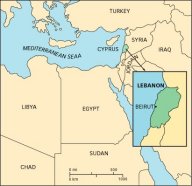


Page 2 of 6
Today Lebanonís population consists of a rich racial mix, containing elements from almost every country in the region. In terms of religion, Muslims constitute about three quarters of the population, Christians about one quarter. Arabic is the dominant language but both English and French are widely spoken.
The political and economic balance that enabled Lebanon to prosper after independence could not continue. The foundation of Israel in 1948, the expulsion of wave after wave of hundreds of thousands of Palestinians from their homes in Palestine into neighboring countries, have kept the region in a permanent state of disequilibrium. In the 1970s the Palestine Liberation Organization (PLO), expelled from Jordan in 1971, established themselves in Lebanon. The arrival of a large dispossessed community in a country which was already performing an extraordinary balancing act between its different religions and traditions, combined with the destabilizing effect of Israelís pre-emptive and retaliatory strikes against the PLO wherever they were, inevitably destabilized the country.
In 1975, violent incidents involving Palestinians and Christian Phalangists escalated into a civil war between the Muslim and Christian communities. This conflict soon led to increased Syrian involvement in Lebanese affairs. By May 1976, Syria was reckoned to have at least 40,000 troops in Lebanon.
Throughout this period, the Kingdom of Saudi Arabia deployed its diplomatic skills in order to find an equilibrium between the Lebanese factions (including the Palestinians) and the Governments of all the Arab countries involved (Syria, Egypt and Jordan) but it is scarcely surprising that the sought-for stability proved elusive.

